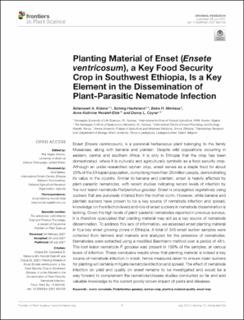| dc.contributor.author | Kidane, Selamawit Araya | |
| dc.contributor.author | Haukeland, Solveig | |
| dc.contributor.author | Meressa, Beira H. | |
| dc.contributor.author | Hvoslef-Eide, Anne Kathrine | |
| dc.contributor.author | Coyne, Danny L. | |
| dc.date.accessioned | 2021-08-25T10:29:41Z | |
| dc.date.available | 2021-08-25T10:29:41Z | |
| dc.date.created | 2021-08-06T17:07:48Z | |
| dc.date.issued | 2021 | |
| dc.identifier.citation | Frontiers in Plant Science. 2021, 12 . | |
| dc.identifier.issn | 1664-462X | |
| dc.identifier.uri | https://hdl.handle.net/11250/2771136 | |
| dc.description.abstract | Enset (Ensete ventricosum), is a perennial herbaceous plant belonging to the family Musaceae, along with banana and plantain. Despite wild populations occurring in eastern, central and southern Africa, it is only in Ethiopia that the crop has been domesticated, where it is culturally and agriculturally symbolic as a food security crop. Although an under-researched orphan crop, enset serves as a staple food for about 20% of the Ethiopian population, comprising more than 20 million people, demonstrating its value in the country. Similar to banana and plantain, enset is heavily affected by plant-parasitic nematodes, with recent studies indicating record levels of infection by the root lesion nematode Pratylenchus goodeyi. Enset is propagated vegetatively using suckers that are purposely initiated from the mother corm. However, while banana and plantain suckers have proven to be a key source of nematode infection and spread, knowledge on the infection levels and role of enset suckers in nematode dissemination is lacking. Given the high levels of plant-parasitic nematodes reported in previous surveys, it is therefore speculated that planting material may act as a key source of nematode dissemination. To address this lack of information, we assessed enset planting material in four key enset growing zones in Ethiopia. A total of 340 enset sucker samples were collected from farmers and markets and analyzed for the presence of nematodes. Nematodes were extracted using a modified Baermann method over a period of 48 h. The root lesion nematode P. goodeyi was present in 100% of the samples, at various levels of infection. These conclusive results show that planting material is indeed a key source of nematode infection in enset, hence measures taken to ensure clean suckers for planting will certainly mitigate nematode infection and spread. The effect of nematode infection on yield and quality on enset remains to be investigated and would be a way forward to complement the nematode/disease studies conducted so far and add valuable knowledge to the current poorly known impact of pests and diseases. | |
| dc.language.iso | eng | |
| dc.title | Planting Material of Enset (Ensete ventricosum), a Key Food Security Crop in Southwest Ethiopia, Is a Key Element in the Dissemination of Plant-Parasitic Nematode Infection | |
| dc.type | Peer reviewed | |
| dc.type | Journal article | |
| dc.description.version | publishedVersion | |
| dc.source.pagenumber | 6 | |
| dc.source.volume | 12 | |
| dc.source.journal | Frontiers in Plant Science | |
| dc.identifier.doi | 10.3389/fpls.2021.664155 | |
| dc.identifier.cristin | 1924484 | |
| dc.relation.project | NORAD, direktoratet for utviklingssamarbeid: NORHED-programmet ETH-13/0017 | |
| dc.relation.project | EU/Grant Agreement 727624 | |
| cristin.ispublished | true | |
| cristin.fulltext | original | |
| cristin.qualitycode | 2 | |
